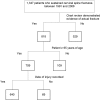Mortality in elderly patients after cervical spine fractures
- PMID: 20194314
- PMCID: PMC2827825
- DOI: 10.2106/JBJS.I.00003
Mortality in elderly patients after cervical spine fractures
Abstract
Background: Despite an increased risk of cervical spine fractures in older patients, little is known about the mortality associated with these fractures and there is no consensus on the optimal treatment. The purposes of this study were to determine the three-month and one-year mortality associated with cervical spine fractures in patients sixty-five years of age or older and to evaluate potential factors that may influence mortality.
Methods: We performed a retrospective review of all cervical spine fractures in patients sixty-five years of age or older from 1991 to 2006 at two institutions. Information regarding age, sex, race, treatment type, neurological involvement, injury mechanism, comorbidity, and mortality were collected. Overall risk of mortality and mortality stratified by the above factors were calculated at three months and one year. Cox proportional-hazard regression was performed to identify independent correlates of mortality.
Results: Six hundred and forty patients were included in our analysis. The mean age was eighty years (range, sixty-five to 101 years). Two hundred and ninety-four patients (46%) were male, and 116 (18%) were nonwhite. The risk of mortality was 19% at three months and 28% at one year. The effect of treatment on mortality varied with age at three months (p for interaction = 0.03) but not at one year (p for interaction = 0.08), with operative treatment being associated with less mortality for those between the ages of sixty-five and seventy-four years. A higher Charlson comorbidity score, male sex, and neurological involvement were all associated with increased risk of mortality.
Conclusions: Operative treatment of cervical spine fractures is associated with a lower mortality rate at three months but not at one year postoperatively for patients between sixty-five and seventy-four years old at the time of fracture.
Figures



Similar articles
-
The old man and the C-spine fracture: Impact of halo vest stabilization in patients with blunt cervical spine fractures.J Trauma Acute Care Surg. 2016 Jan;80(1):76-80. doi: 10.1097/TA.0000000000000894. J Trauma Acute Care Surg. 2016. PMID: 26491800
-
Spinal cord injuries related to cervical spine fractures in elderly patients: factors affecting mortality.Spine J. 2013 Aug;13(8):862-6. doi: 10.1016/j.spinee.2013.01.045. Epub 2013 Mar 1. Spine J. 2013. PMID: 23453576
-
Predicting In-Hospital Mortality in Elderly Patients With Cervical Spine Fractures: A Comparison of the Charlson and Elixhauser Comorbidity Measures.Spine (Phila Pa 1976). 2015 Jun 1;40(11):809-15. doi: 10.1097/BRS.0000000000000892. Spine (Phila Pa 1976). 2015. PMID: 25785957
-
Cervical spine injuries in children: a review of 103 patients treated consecutively at a level 1 pediatric trauma center.J Pediatr Surg. 2001 Aug;36(8):1107-14. doi: 10.1053/jpsu.2001.25665. J Pediatr Surg. 2001. PMID: 11479837 Review.
-
Cervical spine immobilisation in the elderly: a literature review.Br J Neurosurg. 2018 Jun;32(3):286-290. doi: 10.1080/02688697.2018.1445828. Epub 2018 Feb 28. Br J Neurosurg. 2018. PMID: 29488398 Review.
Cited by
-
The epidemiology of traumatic cervical spine fractures: a prospective population study from Norway.Scand J Trauma Resusc Emerg Med. 2012 Dec 21;20:85. doi: 10.1186/1757-7241-20-85. Scand J Trauma Resusc Emerg Med. 2012. PMID: 23259662 Free PMC article.
-
Development and validation of a nomogram for predicting in-hospital mortality of patients with cervical spine fractures without spinal cord injury.Eur J Med Res. 2024 Jan 29;29(1):80. doi: 10.1186/s40001-024-01655-4. Eur J Med Res. 2024. PMID: 38287435 Free PMC article.
-
Simultaneously Combined Anterior-Posterior Approaches for Subaxial Cervical Circumferential Reconstruction in a Sitting Position.Orthop Surg. 2015 Nov;7(4):371-4. doi: 10.1111/os.12200. Orthop Surg. 2015. PMID: 26790982 Free PMC article.
-
Incidence of cervical spine fractures on CT: a study in a large level I trauma center.Emerg Radiol. 2020 Feb;27(1):1-8. doi: 10.1007/s10140-019-01717-9. Epub 2019 Aug 28. Emerg Radiol. 2020. PMID: 31463806
-
Odontoid fractures with neurologic deficit have higher mortality and morbidity.Clin Orthop Relat Res. 2012 Jun;470(6):1614-20. doi: 10.1007/s11999-011-1994-8. Clin Orthop Relat Res. 2012. PMID: 21830169 Free PMC article.
References
-
- Day JC. Population projections of the United States by age, sex, race and Hispanic origin: 1993 to 2050. US Bureau of the Census, Current Population Reports, Series P25-1104 Washington, DC: Government Printing Office; 1993
-
- Centers for Disease Control and Prevention (CDC) Incidence and costs to Medicare of fractures among Medicare beneficiaries aged > or = 65 years—United States, July 1991-June 1992. MMWR Morb Mortal Wkly Rep. 1996;45:877-83 - PubMed
-
- Kuhne CA, Ruchholtz S, Kaiser GM, Nast-Kolb D. Working Group on Multiple Trauma of the German Society of Trauma. Mortality in severely injured elderly trauma patients—when does age become a risk factor? World J Surg. 2005;29:1476-82 - PubMed
-
- Smith DP, Enderson BL, Maull KI. Trauma in the elderly: determinants of outcome. South Med J. 1990;83:171-7 - PubMed
-
- Jensen JS, Tøndevold E. Mortality after hip fractures. Acta Orthop Scand. 1979;50:161-7 - PubMed
Publication types
MeSH terms
Grants and funding
LinkOut - more resources
Full Text Sources
Medical

